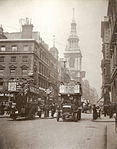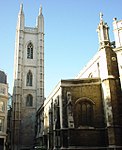St Mary-le-Bow
1680 establishments in England17th-century Church of England church buildingsAll accuracy disputesChristopher Wren church buildings in LondonChurch of England church buildings in the City of London ... and 6 more
Churches bombed by the Luftwaffe in LondonChurches completed in 1680Diocese of LondonEnglish Baroque architectureGrade I listed churches in the City of LondonRebuilt churches in the United Kingdom

St Mary-le-Bow () is a church of Saxon origins, with a Norman crypt, that was rebuilt after the Great Fire of 1666 by Sir Christopher Wren in the City of London on the main east–west thoroughfare, Cheapside. It was badly bombed from enemy aircraft during the Blitz in 1941, and restored between 1956-1964.
Excerpt from the Wikipedia article St Mary-le-Bow (License: CC BY-SA 3.0, Authors, Images).St Mary-le-Bow
Cheapside, City of London
Geographical coordinates (GPS) Address Phone number Website External links Nearby Places Show on map
Geographical coordinates (GPS)
| Latitude | Longitude |
|---|---|
| N 51.513888888889 ° | E -0.093611111111111 ° |
Address
St. Mary-Le-Bow
Cheapside
EC2V 6AU City of London
England, United Kingdom
Open on Google Maps











